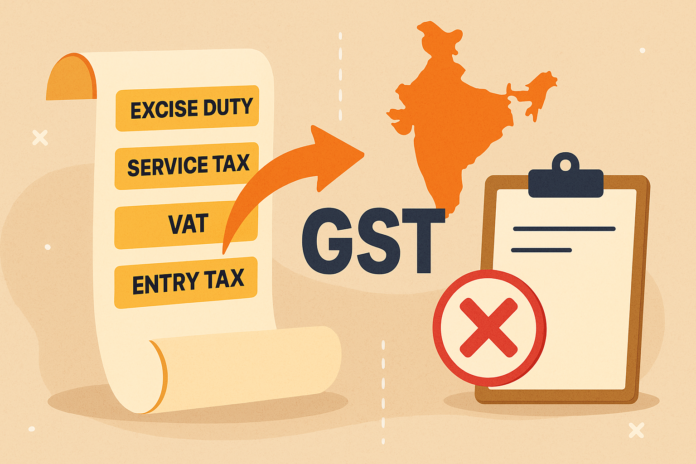Introduction: From Tax Chaos to GST Clarity
Before GST arrived, India’s indirect tax system was a complex web — a mix of Central Excise, Service Tax, VAT, Entry Tax, and more. Each came with its own compliance burdens, often confusing even seasoned business owners and tax professionals.
Then came the Goods and Services Tax (GST) in 2017 — a historic overhaul meant to simplify, unify, and streamline the tax ecosystem. But here’s what many miss: not all taxes were subsumed under GST. While most indirect taxes bid adieu, some still operate independently.
In this article, we’ll break down:
– Which taxes got absorbed into GST
– Which ones remain outside its scope
– How this impacts compliance, billing, and planning
Let’s dive into India’s tax transformation — with examples, legal references, and practical insights.
The Legal Backbone: The 101st Constitutional Amendment Act, 2016
The GST rollout wasn’t just another policy move — it required constitutional restructuring. Key provisions include:
- Article 246A – Empowers both Parliament and State Legislatures to legislate on GST.
- Article 269A – Governs the levy and distribution of IGST on inter-state supplies.
- Article 279A – Constituted the GST Council, which recommends which taxes merge into GST and how.
This constitutional framework ensures cooperative federalism and a unified indirect tax system.
Taxes Subsumed Under GST: Unified & Simplified
GST has subsumed a wide range of Central and State indirect taxes. Here’s the breakdown:
1. Central Taxes Subsumed (under CGST)
- Central Excise Duty (except on 5 petroleum products)
- Service Tax
- Additional Customs Duty (CVD – Countervailing Duty)
- Special Additional Duty of Customs (SAD)
- Central Cesses/Surcharges on goods & services (e.g., Krishi Kalyan Cess, Swachh Bharat Cess)
2. State Taxes Subsumed (under SGST)
- State VAT / Sales Tax (on intra-state transactions)
- Entry Tax / Octroi
- Luxury Tax
- Entertainment Tax (except when levied by local bodies)
- Purchase Tax
- State Cesses and Surcharges related to goods/services
Example:
Before GST, a business in Maharashtra selling goods within the state charged VAT, paid Entry Tax while bringing goods into Mumbai, and levied Service Tax on maintenance services. Now, CGST + SGST replaces all these — simplifying billing and compliance.
Taxes Not Subsumed Under GST: Still Standing
While GST absorbed many taxes, some continue to exist independently due to constitutional, administrative, or revenue considerations.
A. Central Taxes Outside GST
- Basic Customs Duty (BCD) – Levied on imports under the Customs Act, 1962
- Excise Duty on Petroleum Products:
- Crude Petroleum
- High-Speed Diesel
- Motor Spirit (Petrol)
- Natural Gas
- Aviation Turbine Fuel
- Stamp Duty – On immovable property transactions, levied by states under respective Stamp Acts
B. State & Local Taxes Outside GST
- Excise on Alcohol for Human Consumption – States retain full control (Article 366(12A) + exclusion from GST)
- Property Tax – Collected by municipalities
- Electricity Duty – Levied by State Electricity Boards
- Vehicle Tax (Road Tax) – Charged during vehicle registration
- Toll Charges – Collected by authorities on roads/highways
- Entertainment Tax by Local Bodies – On cinemas or events in some states
💡 Example:
If you run a banquet hall in Delhi, GST applies to your service charges and food billing. But property tax on the building and electricity duty on consumption are still payable separately.
Legal & Regulatory References
For those seeking legislative clarity:
- Notification No. 1/2017-Central Tax (Rate) – Dated 28.06.2017 Notified GST rates on goods and services, reflecting the shift from older tax systems.
- CBIC Circular No. 105/24/2019-GST, dated 28.06.2019 Clarifies non-applicability of GST on electricity duty, property tax, and toll charges.
- Rule 54 of the CGST Rules, 2017 Guides the format of tax invoices, showing how to report GST vs. non-GST charges.
- Article 246A Explanation Explicitly excludes alcohol and petroleum products from GST, unless notified later.
Practical Impact for Businesses and Taxpayers
Here’s why knowing what’s in vs. out of GST is not just academic — it has real-world impact:
For Businesses:
- Streamlined Compliance:
One GST return replaces multiple legacy returns like VAT, Service Tax, etc. - Input Tax Credit (ITC) Benefits:
Available for GST components (CGST, SGST, IGST), but not for BCD, stamp duty, electricity duty, or alcoholic beverages. - Billing Clarity:
Ensure invoices clearly separate GST from non-GST charges like municipal taxes or property levies. - Audit-Ready Accounting:
Maintain separate ledgers for non-GST taxes to ensure smooth audits and assessments.
For Individuals:
- Understand your invoices.
GST doesn’t cover property tax, stamp duty, or toll fees — don’t mistake them as GST-inclusive. - Planning a property purchase or import?
Stamp Duty and Customs Duty are over and above GST — factor them into costs.
Summary Table: Subsumed vs. Non-Subsumed Taxes
| Tax | Status Under GST | Levied By |
| Central Excise (non-petroleum) | Subsumed | Centre |
| Service Tax | Subsumed | Centre |
| VAT/Sales Tax | Subsumed | States |
| Entry Tax / Octroi | Subsumed | States |
| Luxury & Entertainment Tax | Subsumed (except by local bodies) | States |
| Property Tax | Not Subsumed | Local Municipalities |
| Stamp Duty | Not Subsumed | States |
| Basic Customs Duty | Not Subsumed | Centre |
| Excise on Alcohol / Petroleum | Not Subsumed | States/Centre |
| Electricity Duty | Not Subsumed | States |
| Road Tax / Toll | Not Subsumed | State Authorities |
Conclusion: Why This Matters More Than Ever
GST undoubtedly simplified India’s indirect tax regime, but it’s not the be-all-end-all. Knowing what’s not covered under GST is just as important as understanding what is.
Whether you’re:
- A business claiming ITC,
- A consultant preparing invoices, or
- A student decoding tax law,
Understanding the split between subsumed and excluded taxes will sharpen your tax planning, reduce compliance risks, and strengthen your advisory game.



